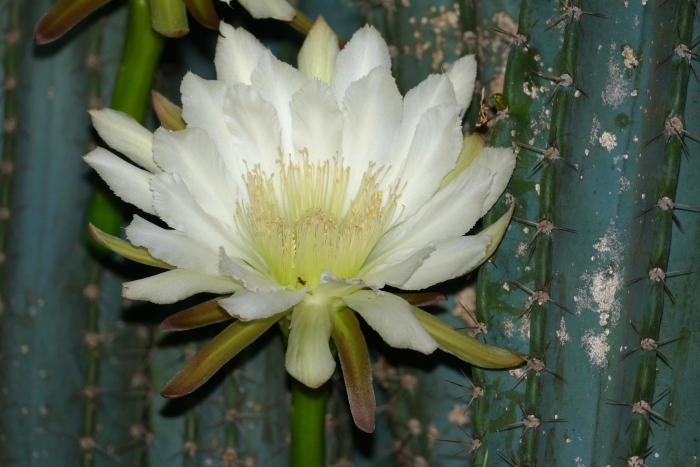Peruvian Apple Cactus
(Cereus repandus)
Peruvian Apple Cactus (Cereus repandus)
/
/

Bernard DUPONT
CC BY-SA 2.0
Image By:
Bernard DUPONT
Recorded By:
Copyright:
CC BY-SA 2.0
Copyright Notice:
Photo by: Bernard DUPONT | License Type: CC BY-SA 2.0 | License URL: https://creativecommons.org/licenses/by/2.0/ | Uploader: Bernard DUPONT | Publisher: Flickr |

























Estimated Native Range
Summary
Cereus repandus, commonly known as Peruvian Apple Cactus, is a large, erect, thorny columnar cactus native to the arid regions of South America, including deserts and dry scrub areas. It often has a tree-like form, with cylindrical gray-green to blue stems that can reach up to 10 meters (33 feet) in height and 10–20 cm in diameter, supporting themselves without the need for external structures. The large, cream-colored, nocturnal flowers are highly adapted for pollination by bats, blooming for a single night and exuding a strong, sweet scent to attract these nocturnal pollinators. The fruits, known locally as pitaya, olala (in some parts of Bolivia), or Peruvian apple, are thornless and vary in skin color from violet-red to yellow. The edible flesh is white and sweetens as the fruit fully matures, containing small, edible, crunchy seeds.
The Peruvian Apple Cactus is valued for its drought tolerance and unique appearance, making it a striking feature in xeriscapes, rock gardens, and as a specimen plant in warm climates. It requires minimal maintenance, thriving in full sun with low water needs and well-drained soils. While it is not commonly grown for its fruit in cultivation, the Peruvian Apple Cactus can provide an exotic edible treat in the home garden. It is important to note that this cactus can be susceptible to root rot if overwatered or planted in poorly draining soils.CC BY-SA 4.0
The Peruvian Apple Cactus is valued for its drought tolerance and unique appearance, making it a striking feature in xeriscapes, rock gardens, and as a specimen plant in warm climates. It requires minimal maintenance, thriving in full sun with low water needs and well-drained soils. While it is not commonly grown for its fruit in cultivation, the Peruvian Apple Cactus can provide an exotic edible treat in the home garden. It is important to note that this cactus can be susceptible to root rot if overwatered or planted in poorly draining soils.CC BY-SA 4.0
Plant Description
- Plant Type: Succulent
- Height: 8-12 feet
- Width: 6-8 feet
- Growth Rate: Slow
- Flower Color: White
- Flowering Season: Summer, Fall
- Leaf Retention: Evergreen
Growth Requirements
- Sun: Full Sun
- Water: Low
- Drainage: Fast
Common Uses
Bee Garden, Bird Garden, Butterfly Garden, Drought Tolerant, Edible*Disclaimer: Easyscape's listed plant edibility is for informational use. Always verify the safety and proper identification of any plant before consumption., Fragrant, Low Maintenance, Rock Garden, Showy Flowers, Street Planting
Natural Habitat
Native to the arid regions of South America, including deserts and dry scrub areas
Other Names
Common Names:
Scientific Names: , Cereus peruvianus, Cereus repandus, Pilocereus repandus, Cactus peruvianus, Cereus margaritensis, Cereus grenadensis, Subpilocereus repandus, Cactus repandus, Cereus lanuginosus
GBIF Accepted Name: Cereus repandus (L.) Mill.